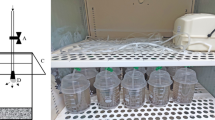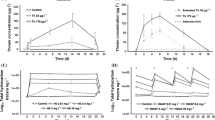Abstract
The study objectives were to shed light on the types of freshwater organism that are sensitive to triphenyltin acetate (TPT) and to compare the laboratory and microcosm sensitivities of the invertebrate community. The responses of a wide array of freshwater taxa (including invertebrates, phytoplankton and macrophytes) from acute laboratory Single Species Tests (SST) were compared with the concentration–response relationships of aquatic populations in two types of freshwater microcosms. Representatives of several taxonomic groups of invertebrates, and several phytoplankton and vascular plant species proved to be sensitive to TPT, illustrating its diverse modes of toxic action. Statistically calculated ecological risk thresholds (HC5 values) based on 96 h laboratory EC50 values for invertebrates were 1.3 μg/l, while these values on the basis of microcosm-Species Sensitivity Distributions (SSD) for invertebrates in sampling weeks 2–8 after TPT treatment ranged from 0.2 to 0.6 μg/l based on nominal peak concentrations. Responses observed in the microcosms did not differ between system types and sampling dates, indicating that ecological threshold levels are not affected by different community structures including taxa sensitive to TPT. The laboratory-derived invertebrate SSD curve was less sensitive than the curves from the microcosms. Possible explanations for the more sensitive field response are delayed effects and/or additional chronic exposure via the food chain in the microcosms.




Similar content being viewed by others
References
Aldenberg T, Jaworska JS (2000) Uncertainty of hazardous concentrations and fraction affected for normal species sensitivity distributions. Ecotoxicol Environ Saf 46:1–18
Aldenberg T, Jaworska JS, Traas TP (2002) Normal Species Sensitivity Distributions and probabilistic ecological risk assessment. In: Posthuma L, Suter II, GW, Traas TP (eds) Species sensitivity distributions in ecotoxicology. Lewis Publishers, Boca Raton, pp 49–102
Baer KN, Goulden CE (1998) Evaluation of a high-hardness COMBO medium and frozen algae for Daphnia magna. Ecotoxicol Environ Saf 39:201–206
Chandra S, Polya GM, James BD, Magee RJ (1989) Inhibition of oxidative phosphorylation by organotin thiocarbamates. Chem Biol Interact 71:21–36
Cima F, Dominici D, Mammi S, Ballarin L (2002) Butyltins and calmodulin: which interaction? Appl Organomet Chem 16:182–186
Cuppen JGM, Van den Brink PJ, Camps E, Uil KF, Brock TCM (2000) Impact of the fungicide carbendazim in freshwater microcosms. I. Water quality, breakdown of particulate organic matter and responses of macroinvertebrates. Aquat Toxicol 48:233–250
De Zwart D (2002) Observed regularities in species sensitivity distributions for aquatic species. In: Posthuma L, Suter II, GW, Traas TP (eds) Species sensitivity distributions in ecotoxicology. Lewis Publishers, Boca Raton, pp 133–154
Eng G, Whalen D, Kirksey A, Otieno M, Khoot LE, James BD (1996) Fungicidal activity of some organotin compounds against Ceratocystis ulmi. Appl Organomet Chem 10:501–503
Fairchild JF, Ruessler DS, Carlson R (1998) Comparative sensitivity of five species of macrophytes and six species of algae to atrazine, metribuzin, alachlor, and metolachlor. Environ Toxicol Chem 17:1830–1834
Fargasová A (1998) Comparison of effects of tributyl-, triphenyl-, and tribenzyltin compounds on freshwater benthos and alga Scenedesmus quadricauda. Bull Environ Contam Toxicol 60:9–15
Farrel AP, Stockner E, Kennedy CJ (1998) A study of the lethal and sublethal toxicity of polyphase P-100, an antisapatain fungicide containing 3-Iodo-2-Propynyl Butyl Carbamate (IPBC), on fish and aquatic invertebrates. Arch Environ Contam Toxicol 35:472–478
Girard J-P, Ferrua C, Pesando D (1997) Effects of tributyltin on Ca2+ homeostasis and mechanisms controlling cell cycling in sea urchin eggs. Aquat Toxicol 38:225–239
Hommen U, Veith D, Ratte HT (1994) A computer program to evaluate plankton data from freshwater field tests. In: Hill IR, Heimbach F, Leeuwangh P, Matthiesen P (eds) Freshwater field tests for hazard assessment of chemicals. Lewis, Boca Raton, FL, pp 503–513
Hose GC, Van den Brink PJ (2004) Confirming the species-sensitivity distribution concept for endosulfan using laboratory, mesocosm, and field data. Arch Environ Contam Toxicol 47:511–520
Hutchinson TH, Solbé J, Kloepper-Sams PJ (1998) Analysis of the Ecetoc Aquatic Toxicity (EAT) database III – Comparative toxicity of chemical substances to different life stages of aquatic organisms. Chemosphere 36:129–142
Jak RG, Ceulemans M, Scholten MCT, Van Straalen NM (1998) Effects of tributyltin on a coastal north sea plankton community in enclosures. Environ Toxicol Chem 17:1840–1847
Juneau P, El Berdey A, Popovic R (2002) PAM fluorometry in the determination of the sensitivity of Chlorella vulgaris, Selenastrum capricornutum, and Chlamydomonas reinhardtii to copper. Arch Environ Contam Toxicol 42:155–164
Koelmans AA, Hubert E, Koopman HW, Portielje R, Crum SJH (2000) Modeling the vertical distribution of carbendazim in sediments. Environ Toxicol Chem 19:793–800
Laughlin RB, Linden O (1985) Fate and effects of organotin compounds. Ambio 14:88–94
Looser PW, Fent K, Berg M, Goudsmit G-H, Schwarzenbach RP (2000) Uptake and elimination of triorganotin compounds by larval midge Chironomus riparius in the absence and presence of aldrich humic acid. Environ Sci Technol 34:5165–5171
Lürling M, Verschoor AM (2003) F0-spectra of chlorophyll fluorescence for the determination of zooplankton grazing. Hydrobiologia 491:145–157
Maltby L, Blake NN, Brock TCM, Van den Brink PJ (2005) Insecticide species sensitivity distributions: the importance of test species selections and relevance to aquatic ecosystems. Environ Toxicol Chem 24:379–388
Mooney HM, Patching JW (1995) Triphenyltin inhibits photosynthesis and respiration in marine microalgae. J Ind Microbiol 14:265–270
Nguyen TT, Ogwuru N, Eng G (2000) Tolerance of Aedes aegypti larvae to triorganotins. Appl Organomet Chem 14:345–348
Payne RW (2002) GenStat® Release 6.1. Reference manual
Petersen S, Gustavson K (2000) Direct toxic effects of TBT on natural enclosed phytoplankton at ambient TBT concentrations of coastal waters. Ecotoxicology 9:273–285
Posthuma L, Suter II GW, Traas TP (2002) Species sensitivity distributions in ecotoxicology. Lewis Publishers, London
Rehage JS, Lynn SG, Hammond JI, Palmer BD, Sih A (2002) Effects of larval exposure to triphenyltin on the survival, growth, and behavior of larval and juvenile Ambystoma barbouri salamanders. Environ Toxicol Chem 21:807–815
Roessink I, Arts GHP, Belgers JDM, Bransen F, Maund SJ, Brock TCM (2005) Effects of lambda-cyhalothrin in two ditch microcosm systems of different trophic status. Environ Toxicol Chem 24: 1684–1698
Roessink I, Crum SJH, Bransen F, Van Leeuwen E, Van Kerkum F, Koelmans AA, Brock TCM (2006) Impact of TriPhenylTin-Acetate (TPT) in microcosms simulating floodplain lakes. I. Influence of sediment quality. Ecotoxicology (accepted)
Schroer AFW, Belgers D, Brock TCM, Matser A, Maund SJ, Blake NN, (2004) Acute toxicity of the pyrethroid insecticide lambda-cyhalothrin to invertebrates of lenthic freshwater systems. Arch Environ Contam Toxicol 46:324–335
Schulte-Oehlmann U, Tillmann M, Markert B, Oehlmann J (2000) Effects of endocrine disruptors on Prosobranch snails (Mollusca: Gastropoda) in the laboratory. Part II: Triphenyltin as a xeno-androgen. Ecotoxicology 9:399–412
Snel JFH, Vos JH, Gylstra R, Brock TCM (1998) Inhibition of photosystem II (PSII) electron transport as a convenient endpoint to assess stress of the herbicide linuron on freshwater plants. Aquat Ecol 32:113–123
Stäb JA, Traas TP, Stroomberg G, Van Kesteren J, Leonards P, Van Hattum B, Brinkman UAT, Cofino WP (1996) Determination of organotin compounds in the foodweb of a shallow freshwater lake in The Netherlands. Arch Environ Contam Toxicol 31:319–328
Stridh H, Orrenius S, Hampton MB (1999) Caspase involvement in the induction of apoptosis by the environmental toxicants tributyltin and triphenyltin. Toxicol Appl Pharmacol 156:141–146
Tiano L, Fedeli D, Santoni G, Davies I, Falcioni G (2003) Effect of tributyltin on trout blood cells: changes in mitochondrial morphology and functionality. Biochim Biophys Acta 1640:105–112
Tillmann M, Schulte-Oehlmann U, Duft M, Markert B, Oehlmann J, (2001) Effects of endocrine disruptors on prosobranch snails (Mollusca: Gastropoda) in the laboratory. Part III: Cyproterone acetate and vinclozolin as antiandrogens. Ecotoxicology 10:373–388
Traas TP, Stäb JA, Kramer PRG, Cofino WP, Aldenberg T (1996) Modeling and risk assessment of tributyltin accumulation in the food web of a shallow freshwater lake. Environ Sci Technol 30:1227–1237
Van den Brink PJ, Brock TCM, Posthuma L (2002) The value of the species sensitivity distribution concept for predicting field effects: (Non-) confirmation of the concept using semifield experiments. In: Posthuma L, Suter II, GW, Traas TP (eds) Species sensitivity distributions in ecotoxicology. Lewis Publishers, Boca Raton, pp 155–193
Van den Brink PJ, Hartgers EM, Fettweis U, Crum SJH, Van Donk E, Brock TCM (1997) Sensitivity of macrophyte-dominated freshwater microcosms to chronic levels of the herbicide Linuron. Ecotoxicol Environ Saf 38:13–24
Van den Brink PJ, Hattink J, Bransen F, Van Donk E, Brock TCM (2000) Impact of the fungicide carbendazim in freshwater microcosms. II. Zooplankton, primary producers and final conclusions. Aquat Toxicol 48:251–264
Van Ewijk PH, Hoekstra JA (1993) Calculation of the EC50 and its confidence interval when subtoxic stimulus is present. Ecotoxicol Environ Saf 25:25–32
Van Straalen NM, Denneman CAJ (1989) Ecotoxicological evaluation of soil quality criteria. Ecotoxicol Environ Saf 18:241–251
Van Vlaardingen P, Traas TP (2002) ETX-2000. A program to calculate risk limits and potentially affected fraction, based on normal species sensitivity distributions
Van Wijngaarden RPA, Crum SJH, Decraena K, Hattink J, Van Kammen A, (1998) Toxicity of Derosal (active ingredient Carbendazim) to aquatic vertebrates. Chemosphere 37:673–683
Vighi M, Calamari D (1985) QSARs for organotin compounds on Daphnia magna. Chemosphere 14:1925–1932
Williams DA (1972) The comparison of several dose levels with zero dose control. Biometrics 28:519–531
Acknowledgements
This study was subsidized by the Netherlands Organization for Scientific Research (NWO) as part of the Stimulation Program System-oriented Ecotoxicological Research (SSEO) (project no. 014.23.012). In addition, the research was supported by the UK Department of Environment, Food and Rural Affairs (Defra) and the Dutch Ministry of Agriculture, Nature and Food Safety, as part of a research program focusing on the scientific underpinning of risk assessment procedures for fungicides in the aquatic environment. The authors are indebted to L. Buijse, A. Matser, and L.J.T. van der Pas for practical assistance.
Author information
Authors and Affiliations
Corresponding author
Rights and permissions
About this article
Cite this article
Roessink, I., Belgers, J.D.M., Crum, S.J.H. et al. Impact of triphenyltin acetate in microcosms simulating floodplain lakes. II. Comparison of species sensitivity distributions between laboratory and semi-field. Ecotoxicology 15, 411–424 (2006). https://doi.org/10.1007/s10646-006-0063-7
Accepted:
Published:
Issue Date:
DOI: https://doi.org/10.1007/s10646-006-0063-7




